Like all of you, I spend an inordinate amount of time daydreaming about cars and travel. One of the recurring daydreams that hopefully will one day come to life is the idea of buying an older car out west and driving it back east on secondary roads. Just myself and a reliable classic of some sort on the open road. Lately, those daydreams have solidified into wanting a prewar Mopar coupe of some sort. T.J., our faithful reader with a bloodhound’s nose for cool cars, may have found the perfect vehicle. Look at this 1942 Dodge coupe for sale on eBay in Grass Valley, California. This just-under-the-wire prewar Dodge has been refurbished to the point that it would make a great travel companion with just one improvement needed. With bidding at $9,600, could this be the right car for the trip?
My cross-country daydream probably is similar to the ones you’ve had. Only the cars and routes may be different. First off, I know this is a dream because I always start with plenty of money, and all the time I need to go at the pace I desire. From there, the idea is to find a car off eBay or some club site, have an expert inspect it, send it to a local garage for prep and any required maintenance, then fly out to start the journey. After exchanging money and a shakedown cruise, it is off to Wal-Mart for a cooler, ice, drinks and snacks, and anything else I need for the trip. That night at the hotel, my dream always has me plotting out the route on old-school folding maps.
What would be the best horse before we place the cart before the horse? My dreams have included Model A sedans, a Chrysler Airflow coupe with overdrive, 1949 Cadillac coupe, 1953 -1957 Corvettes, 1955-1957 Thunderbirds, 1973 Cadillac Coupe deVille, and a new Corvette. When thinking practically, the choices are narrow. The idea would be to have the car be a bit challenging to use as daily transportation in comparison to a modern car without being uncomfortable. It would also have to attract some attention, but not have the same visual equivalent of the Rose Bowl Parade while traveling through small towns. A well-deserved reputation for reliability would be a big factor.
This is where we come back to prewar Mopar coupes. They are not only reliable and proven designs that could be driven comfortably on secondary roads, but they are also within my price range if I got rid of some of this cool stuff that is cluttering up my life. Consolidation, if you will. The ideal car for me would be a 1941 Plymouth coupe. My reasons? Understated good looks, hydraulic brakes, solid construction, and the reliable 23″ Mopar inline-six. I could see myself cruising some backroad out west at the wheel of one of these Plymouths and enjoying it when I finally got home.
Who cares if this car is one year off and one brand off? This 1942 Dodge coupe is a rare car made at a time when the world was changing very quickly. In September of 1941 Dodge debuted a completely restyled product line that was larger in almost every dimension, enclosed the running boards, and offered an early form of a semi-automatic transmission called “Fluid Drive.” Offered in Deluxe and Custom trims, these new Dodges were good sellers and represented a good value for consumers. Once we were actually in the war, the automakers knew that war production would soon take precedence. After the first of the year, chrome trim was no longer allowed due to metal rationing. Cars made after January 1 of the new year featured painted trim and were commonly referred to as “blackout” models. All Dodge domestic automobile production stopped on February 24 of that year. Around 1/4 of a regular year’s production ended up hitting the dealerships.
This car made it out of the factory before that January 1 deadline as we can see from the beautiful chrome trim on the 1942-only grille. Painted in a very beautiful Panama Sand finish, the car presents well. The lack of woodgraining on the dash calls into question whether it is a Deluxe or Custom. Regardless, the ad tells us that the car is in nice shape. It also has an issue: no windshield wipers. Thankfully there are reproduction 6-volt wipers available. Coincidentally, this was the first year that two-speed electric window wipers were available. Anyone who has dealt with vacuum wiper motors has just silently sighed in relief after reading that.
Under the hood is a 230 cubic inch version of the Mopar inline-six. The head has been shaved and a two-barrel carburetor and its required new manifold have been added. To round out the performance modifications, the car also benefits from dual exhaust manifolds. These features are a common way to get a bit more horsepower out of these engines. Modern fuels allow for a bit higher compression and the two-barrel allows for more fuel and replacements are waiting for you at the local NAPA.
This is a car that with a set of wiper motors, wipers, and a once-owner by a good mechanic could be headed across the country in a couple of weeks. Is this the right car for me? Maybe. I like the fact that it is a seldom-seen 1942 model and I am fond of the color. It would definitely do the job. If it sells for anywhere near the current bid, then this could be a great traveling car long after you guided it along the great American road trip.
Have you ever dreamed of traveling across the country in an old car? Have you already made the trip? If not, what car would you choose? Please let us know in the comments.
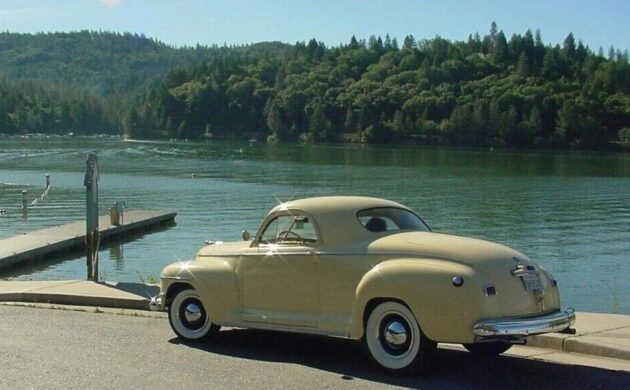
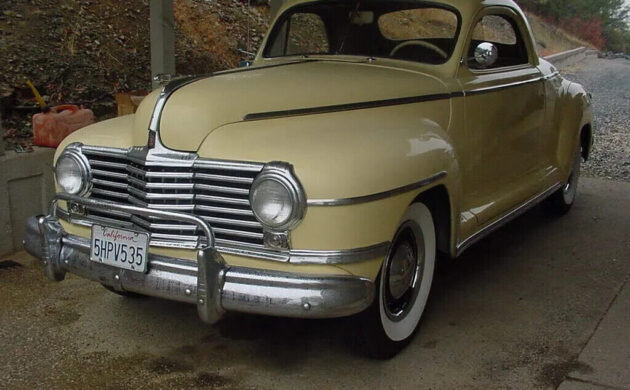
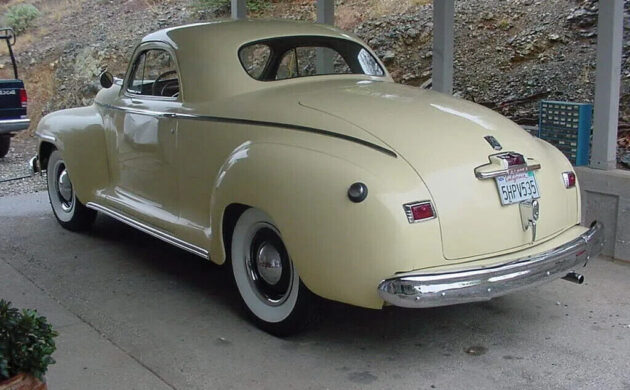
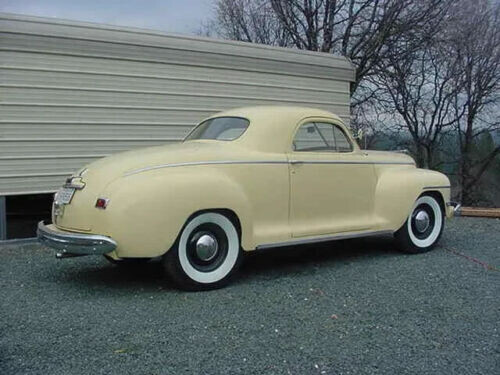
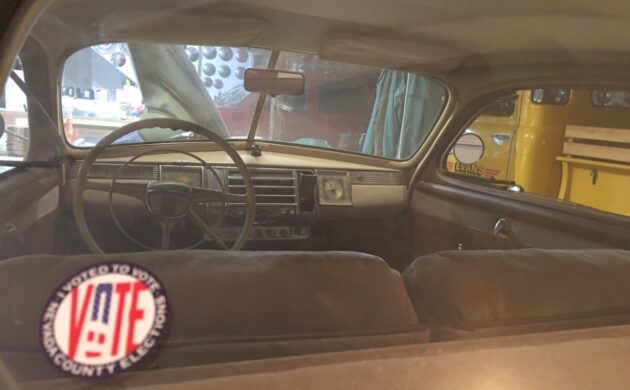
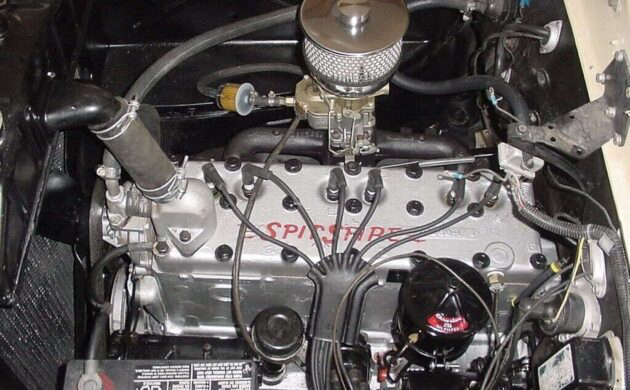




There has been a number of interesting business coupes featured on Barn Finds in the last 6 months or so, and this is near the top of the list for me in terms of desirability. One source I found said that there were only 5,257 of these made. If so, and I think that number is reasonable given that the U.S. was about to declare war on the Axis powers, the rarity of these only increases their appeal. Also, let’s remember to honor those who gave their lives in service to our country on Memorial Day.
I hear that all the time, “oh, I’d just love to take a slow cross country trip in a classic car”, and have horror stories if they actually do. 1st, and foremost, 2 lane back roads have become the bane of most travelers today, having driven a vehicle designed for 55 mph, one is a down right nuisance, and if they can’t pass you, will ride your axx, creating an unsafe situation. 2nd, we tend to forget how reliable newer vehicles are, and breakdowns on even the most seemingly nice running car, can turn ugly quick, at the worst time.( Murphys Law) 3rd, many “old time” 2 lanes have bridges that are no longer safe, and dead ends. Interstate travel takes all the zing out of a classic car ride, I mean, why bother, it was the slow, 2 lane, little towns ride that was what was appealing. Every little town was an adventure. The innerstate[sic] not so much.
Again, it’s a great find, beautiful car( with a big butt), and right at home when everybody drove these, but highway travel “h’aint what it used to be”, and I don’t recommend it whatsoever!
My advice these here days, on something like this, where it’s clearly a nice car, negotiate a deal, rent a car trailer, and schlep it back yourself with your new F150( no EVs, please)
I think a “Route 66” trip, for example, could still be fun (although I on. my one trip I was surprised how far you could go in some areas and not see any cool neon signs or architecture). I would stay off the interstates completely if possible and enjoy the ride. I did this from TN to LA in a modern car and couldn’t imagine going through the desert in an oldie these days, the ’51 Kaiser I had at the time would not have gotten far without overheating. If you want to see more “Route 66” type sights in 5 miles than you might see in 100 miles on that highway, go to Cave City, KY and travel 31 to Horse Cave. You’ll see a WigWam Motel , 5 or 6 other old motels and a LOT of old neon signs in their original state.
yup, isa ‘ride ofa different sort’. I did it & suggest my exact style. Takea huge block of time. B basically goal less (but enjoyin the moment around you). One ‘must visit’ place every few days toa wk, mapped out pre-trip, just gettin into what is simply before U as the real goal. It can B foundational, grounding AND full of life long memories (I take no pic).. Do it alone or only with those on ur wave length. Like a long sea voyage the wrong ppl can ruin it.
I do these trips each decade or so. I try a wk shake down w/use as ‘daily’ and one 2hr cruse. To me this assures a trouble free cruse as I attend to what’s needed then. The last few I’ve hada cellie w/me a nice thing for a ‘growing older guy’. Cant walk my way outta all messes. If I do another I’d like phone numbers for those I’ve met on-line for entertainment or break downs along the way. The Houston to Tampa I would have asked for best po’boys’n juke joints; the Chicago to Memphis may have been BBQ spots?
I may bring back a Toronto vehicle (I90, 8 hrs) which maps out as Rts 5, 318, 96 and so on thu NY State. Planning 2, 3 wks and a wish to sit on several of the larger river’s banks to face some sunsets seems abt right for w/in the nxt month.
These business coups seem absolutely submarine to me, a lill central dog house w/great rounded body to bow & stern…
Huh?
Nice old car. Apparently the dual exhaust system was a later addition as only the first picture has it installed. Also, not sure why the huge tires in back. You could camp your way on the trip to anywhere by sleeping in that huge trunk. Nice detail work on the engine compartment.
I flew out to Missouri and drove the “new “car back to Colorado. I did take the main interstate but did it at night when there was no traffic. It was fun. I also saved the money on a trailer and a new F150 (which I didn’t have).
This is a beauty Bingo!
Hey Bingo, Jeff -A dream of mine also, to take a classic ride at our own pace through backroads.
A lottery win funneled to set up some Restoration shops / Trade schools for young mechanics to be, to bring back more of the older classics that need 90% or just 10%.
No, we are not going to be 100% EV anytime soon. Then sell these to the students to keep them out of $30K + + car debt as they start their careers.
And appreciate what it takes to get mobile and take care of something of value. Good lessons for the young crowd wanting to start simple.
Hey why not a town full of $5K -$20k classics with a new Generation of owners appreciating classics ?
Love this ’42 Dodge!
A nice trip is being made by a couple who left Brazil in a 1929 Ford bound for Alaska.
They are already in Mexico.
Back in 2000 I bought and drove a 1984 Mercedes 500SEC AMG very fast from Mission Viejo California to upstate New York in 24 hours. It was fun.
Average 110 mph for 24 hours?
Nice one, Jeff. My folks had a ’40 Plymouth sedan when I was in high school and college, manual three-speed column shift. The I6 would climb just about any hill in top gear. go 55+ all day, and the brakes were fine, etc. And you could stand two half kegs up in the trunk. I fully support your dream. I’ve thought about something like that myself. After decades of trying to balance maximum safe travel velocity with minimal prison time, I now find the slow lane, two-lane travel, and not being in a hurry quite liberating. People were criss-crossing the nation in the ’40s without a second thought. The most important safety feature is a seat-belt, something you can easily add, and safe driving goes a long way toward avoiding trouble. Thanks for an inspirational write-up and keep us posted on your road trip plans!
RE: a seat belt, I’ve been retrofitting a 3 point retractable shoulder harness (identical to modern car belts) in every old ride I have, currently a ’62 Studebaker GT Hawk. This will prevent you from hitting the dash or windshield in a crash. This, combined with the fact that most “crash zoned” modern cars will self destruct when colliding with heavy Detroit or South Bend steel, makes me feel better about driving around in a classic.
The new cars have their crumple zones at the ends, away from the passenger compartment. Old cars had their crumple zones IN the passenger compartment.
Go for it! I droved a fully loaded ’51 Chevy truck with 140K miles on it from California to upstate NY and even braved the interstates. The only problem I had was the rear main seal started to leak. It was a little embarrassing as the leaked oil built up in the fly wheel housing and dumped when I stopped. Three two gallon cans of oil got me home. I drove it another 100k miles after replacing the engine.
Now we just need Joy Harmon to wash it. :)
As I’ve said before; I’m really into business coupes. Love this one. I think that the cross country trip is a near idea. I’m not plucky enough to attempt it. GLWTS.
I have the same fantasy!
In 75, my dad and I drove his 62 Corvette from Los Angeles to Tulsa. It was a very cool trip. I thought people would go ape over the car, but it was just an old car.
unfortunately, in 84, my dad passed away. I flew back to Tulsa and bought the Corvette from my stepmother and drove it back to LA. I did make one detour onto a section of 66, just so I could take a photo of it with a 66 sign. But basically I stuck to the interstates. I drove mostly non-stop except for an occasional nap.
By then the Corvette was a desireable car and the first time I stopped for gas, the guy offered to buy it.
Of all the strange things to notice, I’m surprised at the gear selector’s position for high gear. Sure looks like the driver’s right knee would bump it….if the driver was taller than 5’10”?
I guess nearly every motorhead has had this dream at least one time in their lives. I know I have. Fact is that
cars built from the ’50s onward were
built to be more reliable and more able to keep up on the interstates. And if you plan to do this, remember to change all fluids and filters before
you start– even if the seller says that
he/she has already seen to that. Keep an eye peeled for worn belts and hoses. And if they are worn, replace them. And if you DIY, pick up
an extra fuel and water pump just in
case you might have an issue along
the way. A good basic set of hand tools and a couple of jugs of water or
antifreeze to round out your kit. A good mini air compressor and some
tire plugs wouldn’t be a bad idea either. Staying on the interstate would be a good idea too. And last but not least, a fully charged cell phone is a must. And if your dream
car is reliable, you can use the GPS to
get you home in one piece. And as
Dinah Shore once sang, …See the USA in your Chevrolet. America awaits for you to call.
True, fix it yourself on the side of the road. If it broke down and had to be towed to a repair shop, the repair people wouldn’t know what to do with it.
Several years ago I rode from Spokane to the Salt Flats with my Brother in Law in his ‘53 Ford. We stuck to secondary roads ;(AKA: the old highway) most of the way. It was an amazing and memorable trip. Only mechanical failure was losing the overdrive solenoid in Missoula on the way home. I’d do it again in a NY Minute. It’s an adventure – which is what makes life worth the living.
This Dodge would be a little slower, but still up to the task. It appears to be in nice shape- but this era of Mopar coupe looks like an over inflated balloon to me. To each his own.
American car designs from this era look so much more modern than those of European cars. That frontal look with the headlamps incorporated into the grille and chrome work in particular, looks quite a few years ahead of their time. European cars did not even start to adopt that type of look until after the war and in many instances not until the 1950s.
I love business coupes from the 30-50s. The Chrysler New Yorker business coupe on here a week or so ago was a beauty. The oversized trunks give the cars an exaggerated sleekness when combined with the small passenger cabs. It also gives plenty of room to put things in the trunk like air ride if you go to restomod route.
Be interested to know what people’s favorite business coupes are. Mine is the bullet nose Studebaker from 50-51.
Road trips in vintage cars: I do them at least annually. Many years ago, I was inspired by Peter Egan’s account of a trip from Iola Wisconsin to Los Angeles in a Model A Ford. My first vintage road trip was in 2003: New Castle Virginia to Portland Oregon in a 1957 MG Magnette. My wife and I drove many miles of it on the old Lincoln Highway, often the Oregon Trail where we read accounts of settlers doing it over 100 years earlier – making eight to ten miles on good days, of infants dying en route, of hired guides that would abandon them on the most desolate stretches, of non-existent roads, broken wagons, and unnamable tragedies. By comparison, our 46-year-old conveyance seemed positively modern, and ours was hardly an adventure. Actually, it was practically trouble-free. I just drove my ’69 MGCGT from Port Huron Michigan to Pensacola Florida and return. Outside of leaking quite a bit of oil and replenishing it frequently, it was a fantastic trip.
But on other trips, we’ve had some adventures along the way. En route from Harbor Beach Michigan to Rohnert Park California in 2007, I replaced the fuel pump on our ’73 MGB/GT on Highway 50 in Nevada (“The loneliest road in America”); back in 2011, I replaced the water pump on the same car in Dodge City Kansas. And last year in nearby Larned Kansas I blew a head gasket on another ’57 MG Magnette, and only a truck/trailer rental from U-Haul would rescue me.
What we don’t hear about anywhere near as much as we should are the absolutely fantastic people one meets on these interrupted journeys. The break-downs themselves become the most memorable warm fuzzy highlights of these adventures. In these troubled times, there are still some wonderful people out there in North America. The combination of a license plate from a state or province a thousand miles away plus an open hood on a vintage car draws out the the best in people – and they often become lifetime friends. Nobody should ever deny him/herself from this golden opportunity to experience humanity at its finest.
What you do first is go through the maintenance sections of the original owner’s manual. For every procedure, you ask yourself when it was previously done. Especially if you don’t know – do it! Carry spare parts! Generator/alternator, water pump, fuel pump, ignition coil, condenser, points, filters, wheel bearings and seals, all rubber (and/or perishable items), although these need to be replaced with new BEFORE the trip. You carry these not because they are so much more likely to fail, but because they might otherwise be very difficult to find. Rebuild all hydraulic systems completely in advance, but carry spare wheel cylinders, caliper kits, spare brake and clutch hoses with you. Sometimes, you carry these things, unneeded, for years – forgetting that spare belts and hoses can rot in your trunk just as they can while in use. Inspect/replace your spares periodically.
Of course you must carry a shop manual for your car; and if there s a favored vendor for those antique parts you might need, carry their catalog. And carry tools! Especially the odd-ball ones that even an experienced mechanic might not have.
You have to learn mechanical self-sufficiency. If you are a diehard originality-purist, you have to bend a little because in many cases there are modern replacement parts for your car that are far more reliable than the originals. Electronic ignition systems come to mind – but don’t go without spares for these too.
This could easily become an essay, but there are few things in life are more satisfying than successfully carrying out a repair on a lonely road a thousand miles from home. Heed the precautions, but DO IT.
‘ See you on the road!
Allen
On my way from New York to Colorado I saw a broken down car with the hood up at 10pm on the highway in desolate Nebraska. I pulled over to help and it was a young beautiful woman in a long dress and tank top.. The engine was shot so I gave her a ride the rest of the way to Colorado where we partied, and she stayed over at my house until we got her to her destination. It was a great memory.
I can fix you up with a really nice 40 P9 business coupe but it’s in central Ky so unless you made a huge loop your ride home would be quite abbreviated. All original still 6 volts, drive it anywhere. Would be nicer if the bias ply tires were put in the huge trunk for the trip and a spare set of radials were installed. I drive it on a regular basis however on the bias skinnies. I’d post pics but your site won’t allow it.
In the 1940’s, beginning around 1942 and lasting through 1948, Chrysler Corp built long rear coupes in almost if not all their brands. They had no back seat, and were called Business Coupes. Salesmen would store their wares in those big trunks and be off for the day or their two-three day trips selling their wares. Most of these cars were company cars or owned by small business owners who traveled around from town to town and earned a living out of the trunk of that car. It’s a nice reminder of the years gone by when Detroit built different cars that weren’t SUVs or crossovers. They had shape and style. In these cars, the spare tire and jack was behind the drivers seat, because the trunk was for the merchandise.
Auction ended with reserve not met at 10,195